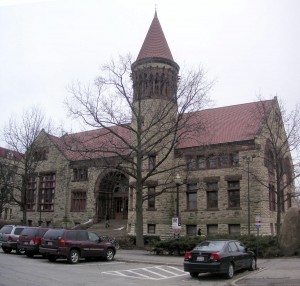By Melissa Block
One of the most historically well-known buildings on Ohio State campus is Orton Hall. Built by architects Joseph W. Yost and Frank L. Packard (Yost and Packard Architects) in 1893, Orton Hall still stands proudly as the second oldest building of the Ohio State University on the south side of the Oval. The hall houses prominently the Orton geological museum, as well as the Orton Memorial Geology Library and several offices and labs. It is named after Ohio State’s first president, Dr. Edward Orton Sr. As well as being president of the university, he also served as a professor of geology and Ohio State’s geologist. The museum holds one of the largest fossil collections, with over 10,000 of them donated by Orton himself. Because of the historical value of this building, it was put on the National Register of Historic Places, being one of four buildings on campus to receive this title.
Looking at the outside of the building, the architectural style is labeled as “Richardsonian Romanesque architecture” (OSU Arts and Sciences Communications Services). This style is characterized by having “unique and unusual, sculpted shapes”, as seen through the intricate statues propped up on the bell tower and through the complex design of the capitals in the interior hallway (Wentw
orth Historic Styles). Stone was also the main material used, shown especially through the stratigraphic order of the stones making up the building, with the oldest starting from the bottom and increasing through time with the youngest at the top. Forty different Ohio-based stones are used through this order. The intricate statues mentioned above are 24 different extinct creatures that had been restored from animal fossils, encompassing the bell tower of Orton. The bell tower is arguably the main attraction of the building, aside from these interesting sculptures it includes 25,000 pounds of bells that chime for each hour, known infamously to OSU students and even having its own rumors and traditions surrounding it. However, it was not an original piece of the building, having been added in 1915. These original bells were a gift, and have since then tuned differently as well as two other bells being installed. There are several different melodies played by these bells, most commonly Westminster Quarters. The inside hallway, also aforementioned includes capitals forming fossils and human races. Out of these columns, there are 24 each made out of a different stone once again highlighting the Romanesque style through the masonry.
The formation of the stones making up the building form a clear hierarchy through the structure. This hierarchy connects the man-made building to that of the natural process of time and nature.
Orton Hall is located at the mid-southern side of the Oval, allowing for easy and open entrance in. Orton is public to all excluding areas where offices are locating and the private areas of the museum, such as the more invaluable exhibits kept in the basement away from easy access.
Though easily looked over and unnoticed, Orton Hall is a treasure and important and unforgetable piece of OSU’s history.
https://ortongeologicalmuseum.osu.edu/orton-hall
https://ksamedia.osu.edu/work/66760
http://www.wentworthstudio.com/historic-styles/richardsonian-romanesque/
